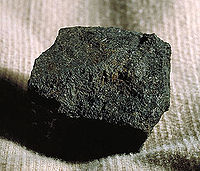
Photo from wikipedia
Tropical peat swamp forest is a global store of carbon in a water-saturated, anoxic and acidic environment. This ecosystem holds diverse prokaryotic communities that play a major role in nutrient… Click to show full abstract
Tropical peat swamp forest is a global store of carbon in a water-saturated, anoxic and acidic environment. This ecosystem holds diverse prokaryotic communities that play a major role in nutrient cycling. A study was conducted in which a total of 24 peat soil samples were collected in three forest types in a tropical peat dome in Sarawak, Malaysia namely, Mixed Peat Swamp (MPS), Alan Batu (ABt), and Alan Bunga (ABg) forests to profile the soil prokaryotic communities through meta 16S amplicon analysis using Illumina Miseq. Results showed these ecosystems were dominated by anaerobes and fermenters such as Acidobacteria, Proteobacteria, Actinobacteria and Firmicutes that cover 80–90% of the total prokaryotic abundance. Overall, the microbial community composition was different amongst forest types and depths. Additionally, this study highlighted the prokaryotic communities’ composition in MPS was driven by higher humification level and lower pH whereas in ABt and ABg, the less acidic condition and higher organic matter content were the main factors. It was also observed that prokaryotic diversity and abundance were higher in the more oligotrophic ABt and ABg forest despite the constantly waterlogged condition. In MPS, the methanotroph Methylovirgula ligni was found to be the major species in this forest type that utilize methane (CH4), which could potentially be the contributing factor to the low CH4 gas emissions. Aquitalea magnusonii and Paraburkholderia oxyphila, which can degrade aromatic compounds, were the major species in ABt and ABg forests respectively. This information can be advantageous for future study in understanding the underlying mechanisms of environmental-driven alterations in soil microbial communities and its potential implications on biogeochemical processes in relation to peatland management.
Journal Title: Scientific Reports
Year Published: 2021
Link to full text (if available)
Share on Social Media: Sign Up to like & get
recommendations!